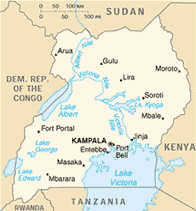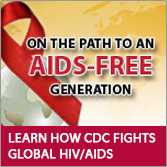Uganda
HIV/AIDS in Uganda
- 7.4% Estimated HIV Prevalence
(Age 15–49) (2013) - 63,000 Estimated AIDS Deaths (2013)
- 1,000,000 Estimated Orphans due to AIDS (2013)
- 403,089 Reported Number of Adults Receiving Antiretroviral Therapy (ART)(2012)
- 70% Estimated ART Coverage per WHO 2010 Guidelines (2012)
SOURCE:
UNAIDS Gap Report, 2014; UNAIDS Global Report, 2013

Strategic Focus
CDC has been working in Uganda since 1991. CDC’s HIV/AIDS office in Uganda was launched in January 2000 and works closely with the Ministry of Health (MoH), local government, and academia, and supports faith-based organizations, civil society, and the private sector to complement activities of the severely burdened public health system. CDC plays a critical role in ensuring delivery of essential health services and commodities.
Strengthening National Public Health Systems
CDC provides technical leadership and direct assistance to the government of Uganda to strengthen the public health workforce capacity, health information systems, epidemiology, surveillance, laboratory services, and operations research – essential components for strong, sustainable public health systems.
Supporting Country Ownership with Integrated Service Delivery
CDC works through local governmental and private not-for-profit institutions to provide high-quality HIV prevention, care, and treatment services throughout Uganda. CDC uses a service-delivery model, which is integrated with national and district processes and structures, thereby building capacity and promoting ownership at all levels of the health system.
Success Stories
- CDC Innovations: Real-Time Data Strengthens Uganda’s Efforts to End Mother-to-Child HIV Transmission
Key Activities and Accomplishments
- CDC supports comprehensive HIV/AIDS prevention, care, and treatment programs in 1,373 health facilities in 54 districts across Uganda.
- In FY 2014, CDC provided antiretroviral therapy (ART) to 394,957 individuals (representing 60% of all U.S. President's Emergency Plan For AIDS Relief (PEPFAR)-supported ART provision in Uganda), care for 489,849 (representing 57% of PEPFAR-supported care in Uganda), and HIV counseling and testing (HCT) to 3.4 million (representing 45% of PEPFAR-supported HCT in Uganda).
- In FY 2014, CDC support provided prevention of mother-to-child transmission services to 50,815 pregnant women (representing 58% of PEPFAR PMTCT outputs in Uganda). Of the 34,153 HIV-exposed infants accessing early infant diagnosis, only 2,481 were HIV-infected and 2,049 of those were initiated on ART.
- In FY 2010, Uganda initiated a national safe male circumcision (SMC) campaign for HIV prevention, and in FY 2014, 329,266 males were voluntarily circumcised with CDC support (accounting for 36% of PEPFAR-supported SMC in Uganda).
- In 2014, with CDC’s assistance and expertise, the MoH activated a specimen transportation network with 78 laboratory specimen referral, testing, and result transmission hubs.
Contact Us:
- Centers for Disease Control and Prevention
1600 Clifton Rd
Atlanta, GA 30333 - 800-CDC-INFO
(800-232-4636)
TTY: (888) 232-6348
24 Hours/Every Day - cdcinfo@cdc.gov
 ShareCompartir
ShareCompartir



